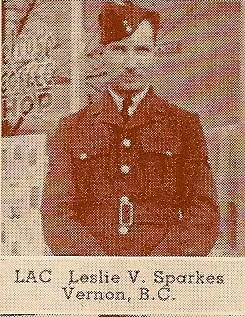Peebles, Vincent Ford (Leading Aircraftman)
Killed in Flying Accident 1942-October-26


Birth Date: 1922-November-08
Born:
Parents: Laffin Michael Peebles & Minnie May (nee Phillips) Peebles
Spouse:
Home: French Village, Nova Scotia (parents)
Enlistment: Halifax, Nova Scotia
Enlistment Date: 1941-June-12
Service
RCAF
Unit
45 (T) Group (RAF)
Base
RCAF Stn. Dorval, Quebec
Rank
Leading Aircraftman
Position
Passenger
Service Numbers
R/104060
Crew or Other Personnel
Ventura AE729
Mission
Ventura Mk. I AE729
Ferry Flight 1942-October-26 to 1942-October-26
5 () Ferry Command (RAF) Dorval, Quebec
RAF Ferry Command, Dorval, Quebec. Ventura aircraft AE 729 had just taken off in poor weather conditions for a flight to Goose Bay, Labrador when it experienced an engine failure, stalled and crashed two miles east of the aerodrome with the loss of all 16 passengers and crew aboard
Crew: American Civilian Pilot Captain CF Kaiser and Canadian Civilian Radio Officer AH Down
Canadian Civilian Passengers: MJ Miles, HS Millen, HC "Bert" Coke and JT Barry were all contractors travelling to Goose Bay to install new equipment for the new airport at Goose Bay, Labrador
Military Passengers: Cpl CT Christopherson (RCAF), Cpl MJ Kasey (RCAF) and eight RCAF Leading Aircraftmen assigned to Goose Bay as radio operators: VF Peebles, LV Sparkes, JF Carr, KD Campbell, PJ Tennant, DA Abbott, BE Malone and WB Danielson
Ocean Bridge, The History of RAF Ferry Command by Carl A Christie pages 257, 314, 394Ventura serial: AE729

A Lockheed PV-1 Ventura
The Lockheed Ventura is a twin-engine medium bomber and patrol bomber of World War II.
The Ventura first entered combat in Europe as a bomber with the RAF in late 1942. Designated PV-1 by the United States Navy (US Navy), it entered combat in 1943 in the Pacific. The bomber was also used by the United States Army Air Forces (USAAF), which designated it the Lockheed B-34 (Lexington) and B-37 as a trainer. British Commonwealth forces also used it in several guises, including antishipping and antisubmarine search and attack.
The Ventura was developed from the Lockheed Model 18 Lodestar transport, as a replacement for the Lockheed Hudson bombers then in service with the Royal Air Force. Used in daylight attacks against occupied Europe, they proved to have weaknesses and were removed from bomber duty and some used for patrols by Coastal Command.
At the start of the war, Lockheed proposed military conversions of the Lodestar for the RAF as replacement for the Hudson reconnaissance aircraft and the Bristol Blenheim bomber. The first British order was placed in February 1940 for 25 Model 32 as bombers. This was followed by an order for 300 Model 37 with Double Wasp engines, then for a further 375 later in 1940. Lockheed needed more production capacity and nearby Vega Aircraft Corporation was contracted for building the Ventura.
The Ventura was very similar to its predecessor, the Lockheed Hudson. The primary difference was not in layout; rather, the Ventura was larger, heavier, and used more powerful engines than the Hudson. The RAF ordered 188 Venturas in February 1940, which were delivered from mid-1942. Venturas were initially used for daylight raids on occupied Europe but, like some other RAF bombers, they proved too vulnerable without fighter escort, which was difficult to provide for long-range missions. Venturas were replaced by the faster de Havilland Mosquito. The Venturas were transferred to patrol duties with Coastal Command as the Mosquito replaced them in bomber squadrons; 30 went to the Royal Canadian Air Force (RCAF) and some to the South African Air Force (SAAF). The RAF placed an order for 487 Ventura Mark IIs but many of these were diverted to the USAAF, which placed its own order for 200 Ventura Mark IIA as the B-34 Lexington, later renamed RB-34.
A total of 157 Ventura G.R. Mk. Vs were used operationally by the RCAF from 16 June 1942 to 18 April 1947 in the home defence coastal patrol role in both Eastern and Western Air Command. They were flown by 8, 113, 115, 145, and 149 Squadrons. A further 21 Ventura Mk. Is and 108 Ventura Mk. IIs were used in a training role at 1 Central Flying School, Trenton, Ontario, and at RCAF Station Pennfield Ridge, New Brunswick (RAF No. 34 Operational Training Unit) as part of the BCATP. A total of 21 Mk. Is, 108 Mk. IIs, and 157 G.R. Mk. Vs were in service during this period for a total of 286 aircraft. Wikipedia
Aircraft Images
Ventura AE729
Ventura Mk. I AE729
{{storedairimage,VenturaAE729.jpg,float:right;width:500px;margin-letf:10px;,Montreal Gazette October 27 1942}}Canada Ferry Command Ventura AE729. Crashed shortly after t/o Dorval. Civilians en route to Goose Bay, Labrador to install equipment at new airport.
The aircraft, carrying 16 people which included 2 Civilian crew members, 10 RCAF airmen and 4 Civilian passengers, was enroute to Goose Bay, Labrador. All 16 perished in the accident. Carl Frederick KAISER, the American civilian pilot, was from Roseville, Michigan, and Arthur Harold DOWN, the Canadian civilian radio operator, was from Tillsonburg, Ontario; the four civilian passengers were to spend the next 6 months installing equipment at the new airport in Goose Bay (they were Charles Herbert 'Bert' Coke (Toronto), H. S. Moden (Montreal), John Joseph Barry (Toronto) and Maurice J. Miles (Toronto). The names of the ten RCAF airmen who perished in the crash were:- Leading Aircraftman Keith Dooks CAMPBELL, Leading Aircraftman Douglas Arthur ABBOTT, Leading Aircraftman John Franklin CARR, Corporal Clifford Thoralf CHRISTOPHERSON, Leading Aircraftman Wesley Bruce DANIELSON, Corporal Michael James KASEY, Leading Aircraftman Bernard Edward MALONE, Leading Aircraftman Vincent Ford PEEBLES, Leading Aircraftman Leslie Vernon SPARKES and Leading Aircraftman Phillip John TENNANT. Hugh Halliday
{{link,canadaprimary,https://heritage.canadiana.ca/view/oocihm.lac_reel_c5934/280,RCAF - Accident Investigation File}}1942-October-26 Accident: RAF Ferry COMMAND Loc: Dorval Airport Names: Abbott | Campbell | Carr | Christopherson | Coke | Danielson | Down | John Barry | Kaiser | Kasey | Maclone | Millen | Morris Myles | Peebles | Sparkes | Tennant









